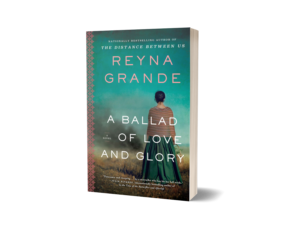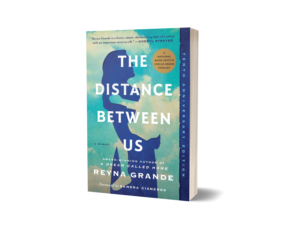Interview with School Library Journal
Reyna Grande on Immigration and “The Distance Between Us”
Award-winning author Reyna Grande has adapted her 2012 best-selling memoir and a finalist for the National Book Critics Circle Award, The Distance Between Us, for adolescent readers (S. & S./Aladdin, Sept. 2016). Grande caught up with SLJ to discuss immigration, the immigrant experience, and tips for librarians on how to welcome and support these often underserved populations. Grande will be speaking at SLJTeen Live! on August 10 as part of the “Stranger than Fiction” panel. Register for the free virtual event here!
The Distance Between Us was initially published for adult readers. Why did you decide to adapt it for teens and tweens?
The United States is a nation of immigrants, and it’s important that our youth have access to stories that reflect this important (and beautiful) aspect of our country. I wanted to offer teens a mirror in which they could see themselves. Seeing their experiences reflected in American literature may make them feel less alone; knowing that their stories matter can be incredibly empowering. For nonimmigrants, this book could be a way for them to learn about their immigrant peers but also an opportunity to remember their own background—for most readers, at some point, someone in their family was an immigrant and went through similar struggles that I write about in my book. Sometimes I feel that people become anti-immigrant because they have forgotten their roots. I’m hoping this book will be an inspirational reminder.
Is there hope in the future for more humane attitudes toward immigrants and immigration? 
I want to say yes, because I am a dreamer and I dream of a world where there is respect for all human beings regardless of where they come from or the color of their skin. But I think we need to do some serious soul searching—not just here in the United States but all over the world, and especially in powerful countries that have a history of denying or failing to recognize that their acts and policies create instability in other countries. In other words, first we create catalysts to make immigrants and then we punish them for immigrating. We are living in the time of the highest ever international migration. There are more displaced people in the world today than ever before. This is caused by many factors, but most of them could be mitigated by more humane foreign and domestic policies and greater awareness.
A crucial scene in the book is during your first day of school in Los Angeles, when your name is shortened from Reyna Grande Rodríguez to Reyna Grande. Not only is this an unnecessary practice but a harmful one, too. Are there ways that librarians and educators can be more aware and respectful?
I feel that just by asking the question you are already working towards the solution! The first thing to do is to recognize that there is something we can all do for child immigrants. Learning about their culture and customs (and their names!) would go a long way in helping them because we can then find ways to reduce their trauma of being in a new country. They will have a hard enough time struggling to figure out American life, and we need to meet them halfway. In learning about their cultures, we can also encourage them to celebrate their roots without ever making them feel ashamed of who they are and where they come from.
The other thing to keep in mind is that these child immigrants [often] carry with them trauma upon trauma, and what they need most is kindness and understanding. Before they can be taught letters and numbers, they need to feel psychologically and emotionally safe. Above all, I would like educators to remember that regardless of where these kids come from, or their legal status, they are—more than anything—simply children, and they need to be more patient and understanding of every child immigrant who walks into their classrooms.
As you age in the memoir, what the “distance between” is, and who it is in relation to, grows in complexity and meaning.
One of the reasons I wrote this book was so that I could help others understand the complexity of the immigrant experience. Sometimes, we tend to focus only on what [the children] go through once they are in the United States. We also need to discuss what happens to them before they even setting foot in the [country]. The struggle doesn’t begin at the U.S. border. Family separation—in all of its forms—has a deep impact on children that will affect them for the rest of their lives. I also want to highlight that any immigrant who has managed to achieve the American Dream has paid a big price for it. For me, I had to deal with the disintegration of my family. What immigrants lose is just as important as what we gain. The experiences of child immigrants are complicated, and we grow up in the United States dealing with issues of belonging, identity, and culture. As the 1.5 generation, we have to fight harder to overcome all kinds of distances so that we can find our place in the world. 
Writing becomes essential for young Reyna. Any advice for aspiring teen writers?
You are never too young to publish. There are many literary journals, online magazines, etc. that welcome works by young writers. Ask your teacher or librarian to help you create a list of publications you can send to, and do it. This will teach you how to prepare your work for submission, how to pitch your work, how to deal with rejection and success, and [how] to balance the writing (art) with publishing (business). Above all, I want teens to remember that if you don’t write your story, you are allowing the powers that be to keep you invisible. Writing is a way to fight disempowerment. And if you don’t write your story, nobody else will. Or worse, if they do write it, they may get it wrong.
In The Distance Between you cite reading Sandra Cisneros’s The House on Mango Street and authors like Isabel Allende, Julia Álvarez, and Laura Esquivel as a revelation—a mirror to your experience. In addition to your forthcoming work, do you have any Chicano/Latino literature recommendations for middle and high schoolers?
There are the classics that I love: Esmeralda Santiago’s memoirs When I Was Puerto Rican and Almost a Woman and Rudolfo Anaya’s novel Bless Me, Ultima. I also enjoyed Pam Muñoz Ryan’s novelEsperanza Rising, Margarita Engle’s memoir Enchanted Air, Guadalupe Garcia-McCall’s novel Under the Mesquite, and Joe Jiménez’s novel Bloodline.
For more mature students, I recommend Daisy Hernández’s memoir A Cup of Water Under My Bed, Justin Torres’s autobiographical novel We, the Animals, Rigoberto González’s memoirs Butterfly Boyand Autobiography of My Hungers.
I could go on and on. The most important thing is for middle and high schoolers to see themselves in the books that they read. Unfortunately, things have not changed that much since I was a middle and high schooler—there isn’t a lot of books by writers of color made available to students in the classroom. But there is always a public library nearby, and hopefully, a wonderful librarian ready to guide these students to the right book.

